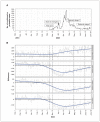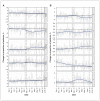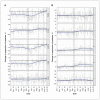Changes in presentation, presenting severity and disposition among patients accessing emergency services during the first months of the COVID-19 pandemic in Calgary, Alberta: a descriptive study
- PMID: 34074633
- PMCID: PMC8177906
- DOI: 10.9778/cmajo.20200313
Changes in presentation, presenting severity and disposition among patients accessing emergency services during the first months of the COVID-19 pandemic in Calgary, Alberta: a descriptive study
Abstract
Background: The COVID-19 pandemic has resulted in unique pressures on the emergency services system. This study describes changes in the presentation, presenting severity and disposition of patients accessing emergency services in Calgary, Alberta, during the first wave of the pandemic.
Methods: In this descriptive study, we constructed a population cohort of all patients who accessed emergency services by calling emergency medical services (EMS) (ambulance service that provides prehospital treatment and transport to medical facilities) or presenting directly to an emergency department (4 adult and 1 pediatric) or 2 urgent care centres in Calgary during the exposure period (December 2019 to June 2020) compared to 2 historical control periods (December to June, 2017-2018 and 2018-2019) combined. Outcomes included frequency of presentation, system flow indicators, patient severity, disposition and mortality. We used a locally estimated scatterplot smoothing function to visualize trends. We described differences at the maximum and minimum point of the exposure period compared to the control period.
Results: A total of 1 127 014 patient encounters were included. Compared to the control period, there was a 61% increase in the number of patients accessing EMS and a 35% decrease in the number of those presenting to an adult emergency department or urgent care centre in the COVID-19 period. The proportion of EMS calls for the highest-priority patients remained stable, whereas the proportion of patients presenting to an emergency department or urgent care centre with the highest-priority triage classification increased transiently by 0.9 percentage points (increase of 89%). A smaller proportion of patients were transported by EMS (decrease of 21%), and a greater proportion of emergency department patients were admitted to hospital (increase of 25%). After the first case was reported, the mortality rate among EMS patients increased by 265% (3.4 v. 12.4 per 1000 patient encounters).
Interpretation: The first wave of the COVID-19 pandemic was associated with substantial changes in the frequency and disposition of patients accessing emergency services. Further research examining the mechanism of these observations is important for mitigating the impact of future pandemics.
© 2021 CMA Joule Inc. or its licensors.
Conflict of interest statement
Competing interests: None declared.
Figures





Similar articles
-
Patients' use of Danish emergency medical services before and during the COVID-19 pandemic: a register-based study.Scand J Trauma Resusc Emerg Med. 2024 Sep 19;32(1):92. doi: 10.1186/s13049-024-01267-1. Scand J Trauma Resusc Emerg Med. 2024. PMID: 39300552 Free PMC article.
-
Factors Associated With Voluntary Refusal of Emergency Medical System Transport for Emergency Care in Detroit During the Early Phase of the COVID-19 Pandemic.JAMA Netw Open. 2021 Aug 2;4(8):e2120728. doi: 10.1001/jamanetworkopen.2021.20728. JAMA Netw Open. 2021. PMID: 34415317 Free PMC article.
-
Have the Diagnoses of Patients Transported by Ambulances Changed in the Early Stage of the COVID-19 Pandemic?Prehosp Disaster Med. 2022 Feb;37(1):4-11. doi: 10.1017/S1049023X21001229. Epub 2021 Nov 10. Prehosp Disaster Med. 2022. PMID: 34753521 Free PMC article.
-
Impact of the COVID-19 pandemic on prehospital emergency medical service: a scoping review.Front Public Health. 2025 Mar 19;13:1543150. doi: 10.3389/fpubh.2025.1543150. eCollection 2025. Front Public Health. 2025. PMID: 40177094 Free PMC article.
-
[COVID-19 Stress test for ensuring emergency healthcare: strategy and response of emergency medical services in Berlin].Anaesthesist. 2021 May;70(5):420-431. doi: 10.1007/s00101-020-00890-8. Anaesthesist. 2021. PMID: 33245381 Free PMC article. Review. German.
Cited by
-
Examining the association between paramedic transport to the emergency department and hospital admission: a population-based cohort study.BMC Emerg Med. 2021 Oct 12;21(1):117. doi: 10.1186/s12873-021-00507-2. BMC Emerg Med. 2021. PMID: 34641823 Free PMC article.
-
The impact of the early COVID-19 pandemic on healthcare system resource use and costs in two provinces in Canada: An interrupted time series analysis.PLoS One. 2023 Sep 8;18(9):e0290646. doi: 10.1371/journal.pone.0290646. eCollection 2023. PLoS One. 2023. PMID: 37682823 Free PMC article.
-
Is 911 The Answer? A Retrospective Review of Emergency Medical Services Use by Home Care Providers.Health Serv Insights. 2023 May 30;16:11786329231178767. doi: 10.1177/11786329231178767. eCollection 2023. Health Serv Insights. 2023. PMID: 37275948 Free PMC article.
-
The impact of the COVID-19 pandemic on transfers between long-term care and emergency departments across Alberta.BMC Emerg Med. 2024 Jan 7;24(1):9. doi: 10.1186/s12873-023-00926-3. BMC Emerg Med. 2024. PMID: 38185672 Free PMC article.
-
Impact of COVID-19 on emergency medical services utilization and severity in the U.S. Upper Midwest.PLoS One. 2024 Oct 1;19(10):e0299608. doi: 10.1371/journal.pone.0299608. eCollection 2024. PLoS One. 2024. PMID: 39352916 Free PMC article.
References
Publication types
MeSH terms
LinkOut - more resources
Full Text Sources
Medical
